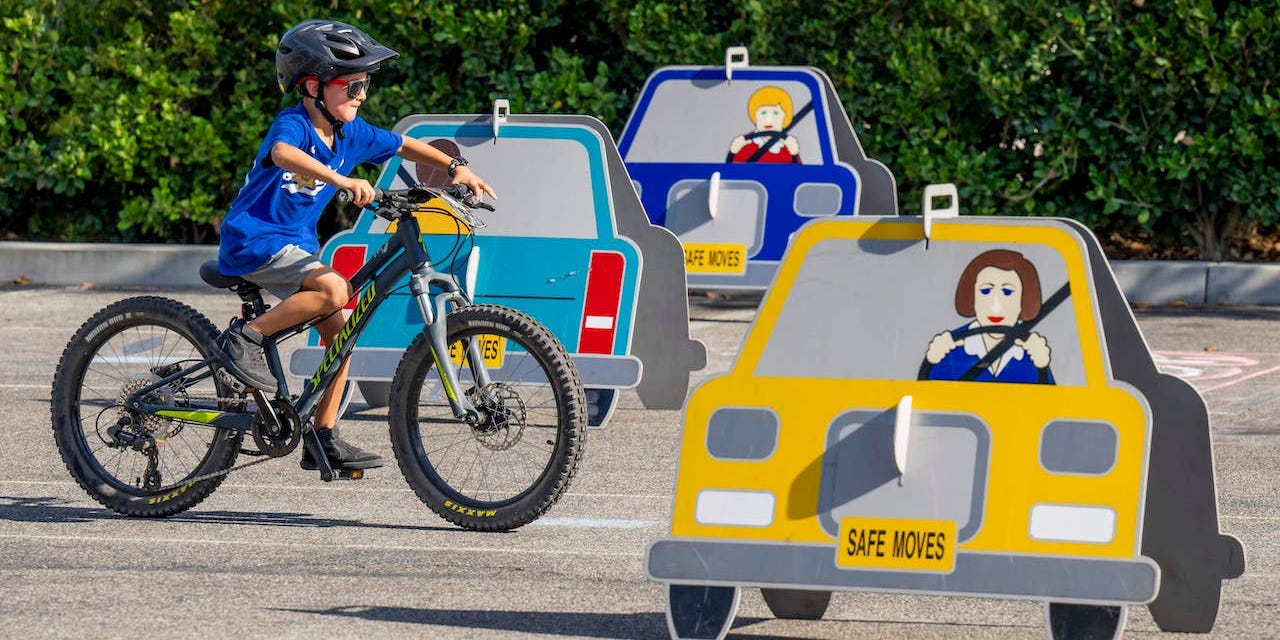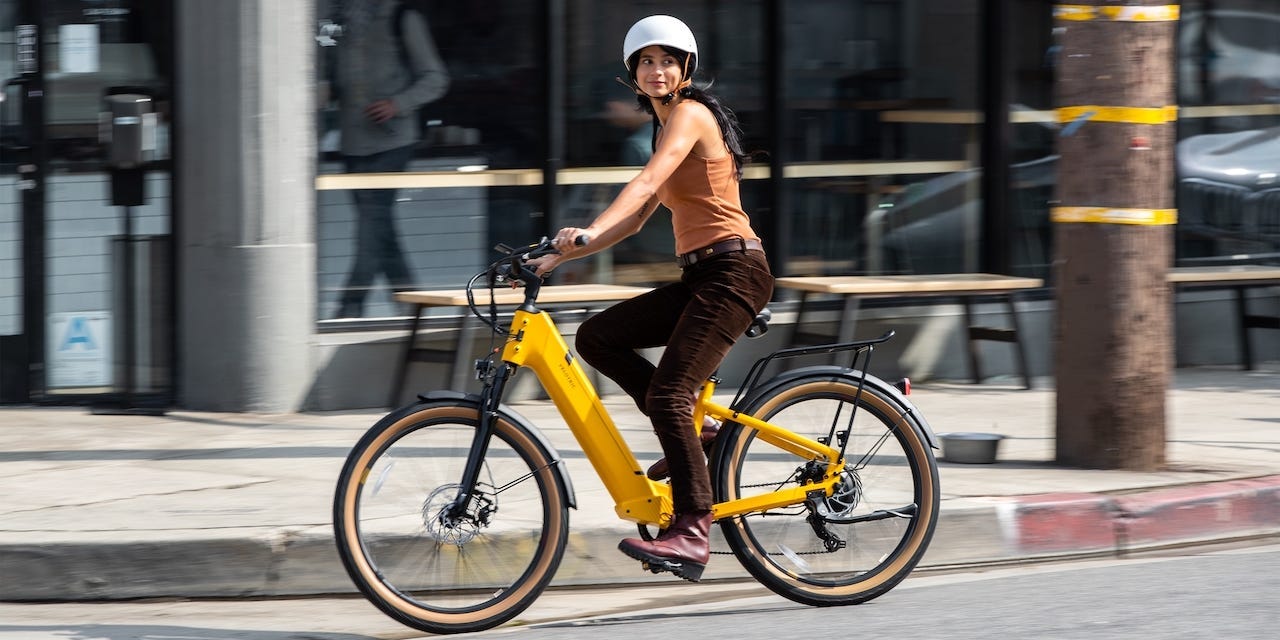SAUL LOEB/Getty Images
- Poor infrastructure makes bicycling harder in the US than many other places.
- Road safety is a major issue that prevents many from biking.
- Advocates are asking for more funding for bike safety measures, in addition to e-bike tax credits.
A forgotten bike lane full of potholes might be the key to unlocking the Biden administration's transportation goals, if only someone would fix it.
With billions of dollars in infrastructure funding pumping through the economy, America is rethinking what its streets, homes, and transit look like. But one trusty form of getting around has been left behind — the humble bicycle.
Advocates say it's a mistake to leave bikes in the dust, even as the federal government seems more focused on funneling money into electric vehicles. Creating real bike infrastructure — and making it accessible to bikers who don't live in wealthy, downtown neighborhoods — can have a big impact on making bikes an option for everyone.
"The joy and freedom that's afforded to me as a person who uses a bike to get around a city is a thing that shouldn't just accrue to folks with the most privilege," Jeff Gang, interim executive director of the Boston Cyclists Union, told Insider.
As the Biden administration looks towards easing the pain of high inflation and gas prices, and fighting climate change, biking might just be a silver bullet. Transportation accounts for the majority of the US's carbon emissions. A 2020 study found that if people rode an e-bike instead of driving a car just 15% of the time, it would reduce emissions by 12%. A 2015 study of bike-friendly Copenhagen found that the cost to society of driving a car is six times as much as cycling, and that while the cost of driving will probably go up, the cost of biking is falling.
"When it's done right," Gang said, "bicycling can be part of a transportation system that really makes it easier for everyone to participate in the city where they live without facing harassment or violence."

Leonard Ortiz/Getty Images
People are scared to ride bikes
Many Americans don't bike because they're worried about safety.
"Safety really is the number one issue," Ken McLeod, policy director at the League of American Cyclists, told Insider. "People don't feel safe on a lot of our nation's roadways."
And they're right to be concerned. The US has an abysmal record when it comes to road safety, particularly for pedestrians and bicyclists, as compared to other wealthy countries. Over the last 20 years, America's roads have gotten safer for drivers and passengers, in part because cars have gotten larger, but have simultaneously become much more dangerous for cyclists, pedestrians, and motorcyclists. And traffic fatalities in the US have spiked over the last few years.
"We know that bicycling as it exists right now feels quite unsafe — and, in many cases, is quite unsafe," Gang said.
It's not that Americans are more reckless or distracted than people in other countries. It's that our street infrastructure is often designed to be dangerous, with high speed limits, few protected bike lanes, poorly marked roads, and chaotic intersections.
"It's not necessarily that one car is speeding on a roadway, it's that the roadway is designed for 35 mile-per-hour traffic and doesn't have a bike lane," McLeod said.

GHI/UCG/Universal Images Group via Getty Images
It's (bike) infrastructure week
Bicycling advocates from around the country descended on DC this week to push Congress to pass the federal Electric Bicycle Incentive Kickstart for the Environment (E-BIKE) Act, which would provide tax credits for e-bike purchases, and the Sarah Debbink Langenkamp Active Transportation Act, which would unlock federal funding for bike and pedestrian infrastructure.
The best way to address biking safety concerns, advocates say, is to build better bike infrastructure, including a robust system of bike lanes.
"The biggest issue that pretty much any city is going to face is creating a safe, accessible bike network that's going to really meet the needs of people of all ages and abilities to enable them to bike and to feel safe while they're biking," McLeod said.
Bike lanes as currently built in many cities often don't connect riders all the way from their starting point to where they want to go.
"You get in the car and you can drive anywhere, you know, you can get to where you want to go," Martha Roskowski, a Colorado-based transportation consultant who attended the Bike Summit this week, told Insider. "You get on a bike and you're like, oh my god, I can make it two-thirds of the way there but then there's a section from hell and I don't want to die."
Bike riders also need accessible storage and charging facilities for e-bikes, Hultin said, particularly for lower-income families who might live in multifamily housing.
Jeremiah Lowery, advocacy director at the Washington Area Bicyclist Association, says his group and others are lobbying Rep. Eleanor Holmes Norton, the non-voting DC representative, for the city to add e-bike charging capabilities to electric car charging stations.

Business Wire/AP Images
An e-bike solution?
Over the last few years, cities and states across the country have rolled out incentives, mostly tax credits, to buy electric bicycles and cargo e-bikes.
The success of some of these policies prompted the introduction of the E-BIKE Act, which would give most Americans up to $1,500 off the purchase of an e-bike. After the tax credit policy was cut from the climate-focused Inflation Reduction Act last year, Democratic lawmakers introduced the bill earlier this month in both the House and Senate.
If passed, the law wouldn't directly address the most pressing safety and infrastructure concerns facing bicyclists, but advocates say it could help. For one, growing the number of people riding bikes would mean fewer cars on the road, making streets safer for bikers. At the same time, this growing community of new bicyclists would likely demand better bike lanes and other infrastructure.
"If you give people access to electric bicycles through some type of incentive, like a tax credit, you're going to create just a whole new army of bike advocates who are out there on the streets," Noa Banayan, director of federal affairs at People for Bikes, told Insider.
Ultimately, advocates say it's about return on investment: More bikes, and better bike infrastructure, could lead to big savings for commuters and a rethinking of how everyone navigates their landscape.
"There's a ton of attention being paid to electric vehicles, and I would encourage policy makers just to think about how much impact you can have with a family e-bike with seats for children or space for carrying groceries or soccer balls or anything else," Gang said. "And think about how much more bang for your buck you can get by subsidizing that than by subsidizing an electric Hummer."
Read More
By: [email protected] (Eliza Relman,Juliana Kaplan)
Title: It's not easy being a bicyclist in the US. Better infrastructure could help.
Sourced From: www.businessinsider.com/e-bike-bicycle-lanes-infrastructure-save-money-fight-climate-change-2023-3
Published Date: Thu, 30 Mar 2023 09:30:00 +0000
.png)





